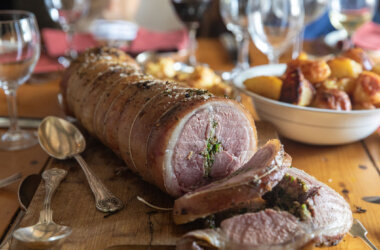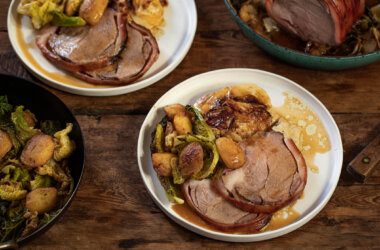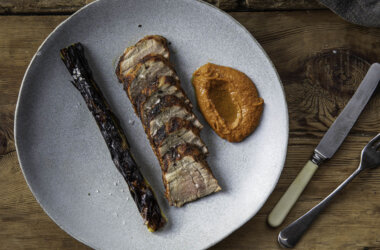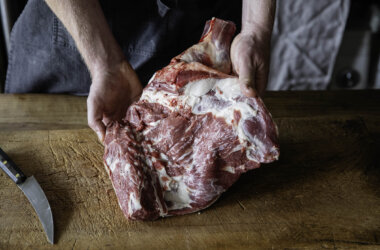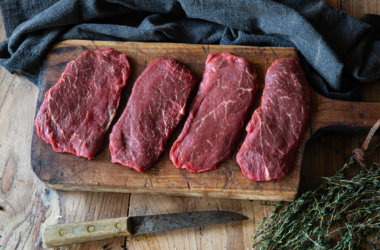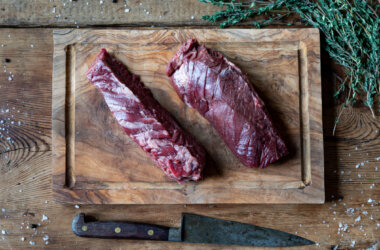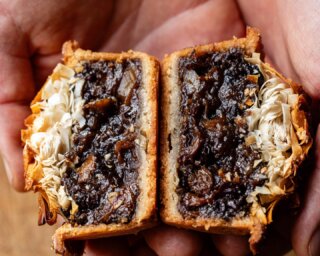
This steak and kidney pudding is a rich, comforting stew encased in a thick layer of suet pastry, rooted in the best traditions of British braising. It remains one of the true classics of these Isles and deserves its place at the centre of the table. Resist the pull of the exotic cookbook now and then, and go British. The sense of anticipation as you cut into that bulging pudding is more than rewarded.
Serves: 6
Prep time: 40 minutes
Cook time: 7 hours
Ingredients
Stew
Suet Pastry
Method
To Make the Pastry
- First, make the pastry. Put the flour, suet, and a teaspoon of salt into a large mixing bowl. Mix together, then make a well in the centre. Add the water and bring the mixture together with your hands. If the dough looks too dry, add a little more water. Knead gently, taking care not to overwork it. Once the dough has come together, wrap it in cling film and leave it to rest in the fridge.
To Make the Stew
- Next, turn your attention to the stew. Trim the kidney, removing the tough white sinew running through the middle, and chop it into pieces about the same size as the beef shin.
- In a bowl, combine the flour, mustard powder, a good pinch of salt, and 6 twists of black pepper. Add the shin and kidney, tossing to coat the meat evenly.
- Place a large casserole pot over high heat and add the dripping. Brown the beef and kidney in small batches, aiming for a nice colour on all sides. Once browned, remove the meat from the pan and set it aside.
- With all the meat browned and set aside, add the carrots, onions, and bouquet garni to the pot, along with a pinch of salt. Sweat the vegetables over medium heat, stirring regularly.
- Return the beef and kidney to the pot, then add the stout and stock. Stir everything together and bring to a boil. Reduce to a simmer, cover with a lid, and let it gently cook for about 1-hour and 45-minutes. Check the seasoning and adjust if necessary.
- Once cooked, remove from the heat and allow it to cool.
To Make the Pudding
- To make the pudding, you will need a pudding basin. Generously grease the inside with any remaining dripping. Take the suet dough and cut off ¾ of it. Roll the larger piece to about ½ cm thick in a circular shape, then use it to line the inside of the pudding basin, pressing it into the bottom and up the sides. There should be some excess pastry over the rim of the basin.
- Roll the smaller piece of dough to the same thickness and shape – this will be the lid.
- Fill the lined pudding basin with the cooled stew, right to the top, reserving a little of the gravy for serving later. Place the pastry lid on top and seal by pressing the lid’s pastry to the excess pastry around the edge. Trim the excess with a knife.
- Cut a sheet of parchment paper large enough to cover the basin, folding a crease into the middle to allow room for expansion as the pudding steams. Secure the parchment tightly around the basin with string or butcher’s twine. Use another length of string to create a handle by tying it across the top of the basin – this will help lift the basin later when it’s hot.
- Take a large pan that is both wide and tall enough to hold the pudding basin. Roll a sheet of tin foil into a sausage shape, then form a ring and place it at the bottom of the pan. This will act as a nest to keep the basin from sitting directly on the bottom. Place the basin on the foil nest and fill the pan with water until it reaches ¾ of the way up the basin.
- Cover the pan with a lid and bring it to the boil, then reduce the heat to a simmer and cook for 4 ½ hours, topping up the water as needed.
- Carefully remove the basin from the pan and untie the string. Remove the parchment paper.
- Find a large enough plate and place it over the top of the pudding. Holding the pudding with a cloth, flip it upside down, then lift the basin off to reveal your steaming pudding – what joy!
- Heat the reserved gravy and pour it over the pudding to serve. Some savoy cabbage, blanched and dressed with a little butter, makes a perfect accompaniment.
